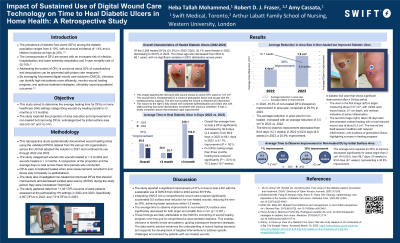Clinical Research
(CR-054) Impact of Sustained Use of Digital Wound Care Technology on Time to Heal Diabetic Ulcers in Home Health: A Retrospective Study
Friday, May 2, 2025
7:45 PM - 8:45 PM East Coast USA Time

Robert D. J. Fraser, MN RN NSWOC WOCC(C) – Swift Medical Inc.; Amy Cassata, BSN, RN, WCC
Introduction: Diabetic ulcers (DUs) are among the most prevalent and challenging chronic wounds, often resulting in prolonged healing times, increased healthcare costs, and reduced patient quality of life.1 Effective management of DUs is critical to prevent complications such as infections and amputations.2 However, traditional assessment methods are often subjective and inconsistent.3 Digital wound care solutions (DWCS) provide standardized and objective wound assessments, offering the potential to enhance healing efficiency and improve patient outcomes.3 This study evaluated the impact of DWCS on DU healing times and improvements in non-healed but improved wounds in home healthcare (HH) settings.
Methods: This retrospective descriptive study analyzed 11,021 DU wounds from 59 HH agencies using DWCS between 2022 and 2023. DU healing times were compared across years, with sub-analyses of wounds healing within three months versus those requiring longer. Non-healed but improving DUs were further assessed for changes in wound area reduction and time to improvement, stratified by initial wound size (≤2 cm² and >2 cm²). Statistical tests, including t-tests and ANOVA, were employed to compare differences in healing times and area reduction
Results: The average healing time for DUs significantly decreased from 98.9 days in 2022 to 68.1 days in 2023, a reduction of 30.8 days (31%, p< 0.001). The proportion of DUs healing within three months increased by 5.3% in 2023 compared to 2022. Among non-healed but improving DUs, the average wound area reduction rose from 4.4 cm² in 2022 to 7.9 cm² in 2023, a 79.5% improvement. Additionally, the time to observable improvement decreased by 22 days (26%), from 84.8 days in 2022 to 62.8 days in 2023 (p< 0.001). Larger wounds ( >2 cm²) showed a greater decrease in time to improvement, with a reduction of 34.9 days (35.6% improvement, p< 0.001).
Discussion: The implementation of DWCS significantly reduced DU healing times and improved wound area reduction for non-healed cases, especially larger wounds. These results highlight the potential of DWCS to optimize DU management, improve clinical outcomes, and reduce the economic burden of prolonged wound care in HH settings.
Methods: This retrospective descriptive study analyzed 11,021 DU wounds from 59 HH agencies using DWCS between 2022 and 2023. DU healing times were compared across years, with sub-analyses of wounds healing within three months versus those requiring longer. Non-healed but improving DUs were further assessed for changes in wound area reduction and time to improvement, stratified by initial wound size (≤2 cm² and >2 cm²). Statistical tests, including t-tests and ANOVA, were employed to compare differences in healing times and area reduction
Results: The average healing time for DUs significantly decreased from 98.9 days in 2022 to 68.1 days in 2023, a reduction of 30.8 days (31%, p< 0.001). The proportion of DUs healing within three months increased by 5.3% in 2023 compared to 2022. Among non-healed but improving DUs, the average wound area reduction rose from 4.4 cm² in 2022 to 7.9 cm² in 2023, a 79.5% improvement. Additionally, the time to observable improvement decreased by 22 days (26%), from 84.8 days in 2022 to 62.8 days in 2023 (p< 0.001). Larger wounds ( >2 cm²) showed a greater decrease in time to improvement, with a reduction of 34.9 days (35.6% improvement, p< 0.001).
Discussion: The implementation of DWCS significantly reduced DU healing times and improved wound area reduction for non-healed cases, especially larger wounds. These results highlight the potential of DWCS to optimize DU management, improve clinical outcomes, and reduce the economic burden of prolonged wound care in HH settings.

.jpg)